War History Online presents this Guest Blog by Miguel Vargas-Caba
The TU-95RTs (Bear D)
In 1970 the Soviet Aviatsiya Voyenno-Morskogo Flota, or Naval Aviation felt that it was time to prepare its crews for transatlantic flights, so they started to organize missions to Cuba. Test flights were made by the Norwegian Sea and the northeastern Atlantic Ocean, calculating fuel consumption and wind currents, aiming towards the long flights to that island. In April 1970 one test flight reached the island. Finally, in May 1970, a fleet of Soviet warships, made up of two Project 641 (Foxtrot) submarines, a guided-missiles cruiser, a guided-missiles destroyer, a floating submarine pen, and one nuclear submarine Project 675 (Echo II) arrived at the port of Cienfuegos, on the southern coast of the island. At the same time, between May 18th and 21st, three pairs of Tupolev TU-95RTs (Bear D) long-range reconnaissance airplanes took off from the USSR. Of these, the first were a pair of airplanes belonging to the 392nd Independent Long-Range Reconnaissance Aviation Regiment (ODRAP in Russian). Piloted by Majors Ivan Fyodorovich Gladkov and Vladimir Stepanovich Melennyy (leading), and Alexey Ivanovich Startsev and Danila Flegontovich Flegontov (led), they took off from Kipelovo/Fedotovo, Vologda, to participate in the Okean Maneuvers of the Soviet Navy, flew through the Iceland-Faeroes gap, and continued their flight towards Cuba. When they landed at Havana’s José Martí airport, they completed the first transatlantic flight of a TU-95 in military service. Those six TU-95 operated from the island while the Soviet warships were present.
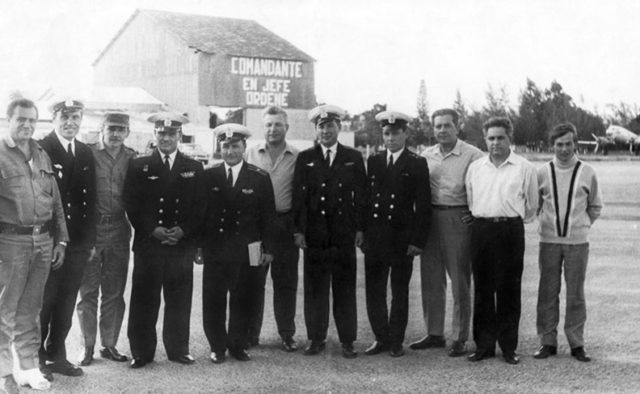
These flights to Cuba started a new phase in the military activities of the 392nd ODRAP’s Bears. They also began the mastery of flights in military service with the use of airfields in friendly nations, which increased even more the possibilities of conducting military operations over the waters of the whole Atlantic Ocean.
From then on, TU-95s appeared in the Cuban skies from time to time, with a regular periodicity of about 25 to 35 flights a year, but in November 1981 they were based there permanently, in quantities from 2 to 12 airplanes. They took off almost daily from the San Antonio de los Baños airfield, some 20kms southwest of Havana, in the usual pair, following the system of leading and led aircraft in use by the Soviet Navy in those days, to patrol the American eastern seaboard just outside the territorial waters, from Miami all the way to Washington, DC and New York.
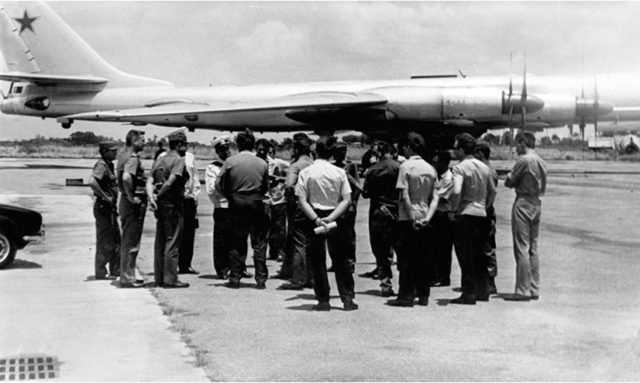
Subsequently, the flights from the Cuban airfields were mastered by all the crews of the regiment. During its entire deployment there, which lasted almost up to the disintegration of the USSR, the TU-95 performed 756 flights in military service. In the process, some special features of the region were studied. In the portion of the route from Latitude 55o to Latitude 36 o N the crews encountered the Jetstreams, whose speeds at the altitudes between 5,000m to 10,000m sometimes reached between 200kph and 300kph, thus increasing the duration of the flight by two and a half to three hours. Sometimes the flights to the island were impossible.
In the portion of the route from Latitude 60° to Latitude 30° N, at an altitude of 9,000m to 10,000m, in an area with a length of 800km to 1,500km and a depth of up to 150km, the pilots also met frontal cloudiness and separate Cumulus Congestus clouds. In these cases, it was necessary to deviate 100km to 200km from the specified heading.
Another very important issue was the increase in air temperature from the standard atmosphere, which reached 10 to 15 degrees more in the portion of route south of Latitude 40° N. This also led to an increase in fuel consumption. The average hourly fuel consumption in a regime of maximum range at a speed between 710kph and 740kph was about 4.91 tons, with a mean consumption of 7.5 kg/km, which was about 12% to 14% more than the calculated values.
For the crews it was also necessary to consider the intense air traffic between the old and the new worlds, in order to select flight altitudes between the echelons of international air lines. Similar overflights were characterized by their complexity and required a lot of physical and psychological preparation on the part of the crews, in order to utilize the means of radiotechnical safety available along the flight route. Gradually, uncertainty gave way to professionalism and to a greater belief in their abilities. The situation in Cuba was friendly, and the relations between the Cubans and the Soviet flying and technical personnel was like that of close relatives.

For the northerner Russians, not spoiled by the comforts and by the sun, even a short term stay in Cuba, under the excellent conditions enjoyed there, gave them and outstanding emotional relief.
The possibilities of performing reconnaissance duties using airfields in friendly nations grew substantially. So, thanks to the opportunity of having TU-95RTs based in Cuba, it was possible to detect in the Western Atlantic Ocean two carrier-based strike groups, which were sailing from the American east coast into the Norwegian Sea to participate in NATO’s “Strong Express” maneuvers in 1972. Both groups were kept under observation for two days by TU-95RTs, which took off from Cuban airfields. After that, the reconnaissance was continued by aircraft of the Northern Fleet based in the USSR.
All this increased the confidence that, during extraordinary situations, foreign aircraft carriers would not approach Soviet waters unnoticed.
Thanks to their “Uspyekh” radar system, the RTs version of the TU-95 (known by NATO as the Bear D) served as a reconnaissance and target acquisition platform for the nuclear cruise missiles type P-6 (SS-N-3 Shaddock) carried by submarines of the Project 651 (Juliett) and 675 (Echo II) class, which carried 4 and 8 missiles each, respectively. These missiles, with a range of 500km, could strike small targets with their nuclear warheads thanks to their onboard radar guidance system “Antey.” The TU-95 reconnoitered and acquired the target, then through its “Arfa” data transmission system, sent the data in a continuous stream to the missile until the onboard terminal guidance system took over. Soviet sources said about this event: “With the appearance of the TU-95RTs in Cuba, its strategic importance increased considerably.” Almost all the industrial centers of importance on the American east coast were placed under the threat of a possible nuclear strike by the Soviet submarines in the area. In the same manner they could also attack American aircraft carriers and ships.
These patrols, carried out by the TU-95RTs, and called “Orient Express” by the West, were usually escorted by US Fighters. In their flights from and to the USSR, they were also intercepted by American (F-4 Phantom II and F-15 Eagle of NORAD, and F-14 Tomcat of the US Navy) and Canadian (CF-101 Voodoo, which flew until 1987) interceptors. With these flights they frequently tested the North American defense system as they flew along the edge of its air space. When they reached the Northern Atlantic, fighters from other NATO countries escorted the TU-95s. The American fighters got so close that sometimes there were unexpected dangers. This also violated the SALT agreement signed between the USSR and the USA on the 25th of May, 1972, to avoid incidents on the high seas and the airspace above. The agreement stated: “The pilots of the airplanes should show great care and common sense when approaching the opponent’s aircraft.” Usually, the American fighters only left the TU-95 when these entered the Cuban Air Defense Zone.

San Antonio de los Baños airbase, 1973.
In November 1972 a TU-95RTs of the 392nd ODRAP, piloted by the Deputy Commander of the Squadron, Major Khadartsev, had an emergency landing at the José Martí Airport in Rancho Boyeros, Havana.
A long-range reconnaissance flight was carried out, as usual, by a pair of TU-95RTs aircraft. Leading was the Regimental Commander at the time, Major V.I. Dubinsky, with Major Khadartsev being the led. The pair took off from the airbase at Olen’ya (Olenyegorsk), Kola Peninsula, USSR. Seventeen hours later they approached the airfield in Havana in the middle of worsening meteorological conditions (a thunderstorm was raging), and without the help of radio navigational equipment. At that time the José Martí airport had only one homing station available, and that with reverse heading. The leading aircraft was the first to land, immediately taxiing into the tarmac area in order to free the runway for the led aircraft. While performing the descent maneuver, Major Khadartsev saw the runway too late, nevertheless, he continued the descent at a 20° angle. Reaching too low an altitude, the pilot began to make a corrective turn over the runway head when the right wingtip made a sudden dip, and the propellers of the fourth engine touched the ground, pushing the wing up and allowing the plane to land. The propellers, however, disintegrated and started to chew on the number three engine and the fuselage. Only the frantic efforts of the Cuban fire and rescue squads saved the aircraft. The crew was unharmed, but the aircraft sustained severe damages. All this happened before the eyes of numerous passengers at the international airport terminal.
On January 3rd, 1973, the Deputy Commander of the 392nd ODRAP, Lt. Col. Grigoriy Emelyanovich Filonenko, made the test flight of the TU-95RTs of the 392nd ODRAP that had been damaged the previous November of 1972, at the beginning with a light load, then with a full load. After the test flight he proceeded to bring the airplane back to the USSR.
From the recollections of Lt. Col. G. E. Filonenko: “During the test program we found a large quantity of malfunctions, which could not be repaired under the existing conditions at the time in Cuba. Understanding the total responsibility and complexity of the task, and the enormous risk connected with the flight, I, nevertheless, decided to carry out the return flight of this aircraft back to the USSR.
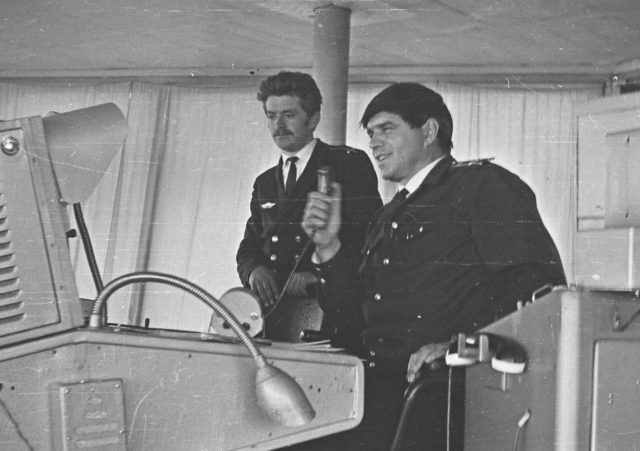
Flights from and to Cuba over the Atlantic and Arctic Oceans in Soviet aircraft were always carried out in pairs. This time, however, I was ordered to fly alone. On January 4th, 1973, at 6:00 in the morning, Havana time, I took off and headed towards my native country. Flying by the Bermudas, part of the radio-navigation system failed. The navigator proposed to return, since the passage through the narrow zone between the Faeroe Islands and Great Britain required precise navigation in order not to violate their territorial waters. The engines worked normally, and the gyromagnetic compass worked, so I made the decision: to continue flying. We flew towards the sun, therefore, daylight ended 5 hours after takeoff.
Nearing Severomorsk, they proposed me to land there, but I decided to continue the flight to our airbase at Kipelovo. At 5am, Moscow time, the heavily wounded machine, which had flown over two oceans and between two continents, landed at its home airfield.
After I switched off the main taxiing engines and descended from the plane, I saw on the concrete the shadow of my aircraft, drawn by the aviation fuel that poured from all available holes. When the rear technical section of the airplane was opened up, the technician that was standing under it was immediately soaked in kerosene as if from a bucket. Many fellow aviators came to see the aircraft. The Regiment Engineer, G. A. Sosnovskiy, approached me and said: ‘I have seen a lot in aviation, but that they could fly in an airplane in this condition, to me, that’s a first.’ In any event, the critical task was executed as ordered.”
Several incidents with the TU-95s became symbols of the tensions reigning during the Cold War. One of those airplanes took off from Cuba, and after patrolling the American eastern seaboard, made its return circle too wide, so it entered American airspace, provoking protests. In another incident, a TU-95 violated American airspace in full daylight. Flights by TU-95s over the American base at Guantanamo happened once in a while, generating the corresponding scandal. In September 1979, during the VI Congress of the Non-aligned Nations Movement in Havana, The Cuban Minister of Defense, Raul Castro, asked the Soviet Ambassador, Vitaly Vorotnikov, to suspend the flights for several days, so the US could not use them as a pretext and accuse Cuba of being aligned. The American then used as a pretext the “discovery” of a Soviet Motorized Brigade near Havana (something they knew about since 1962), which started the usual crisis. Due to those events, the USSR prolonged the suspension of the TU-95 flights throughout October and November 1979.
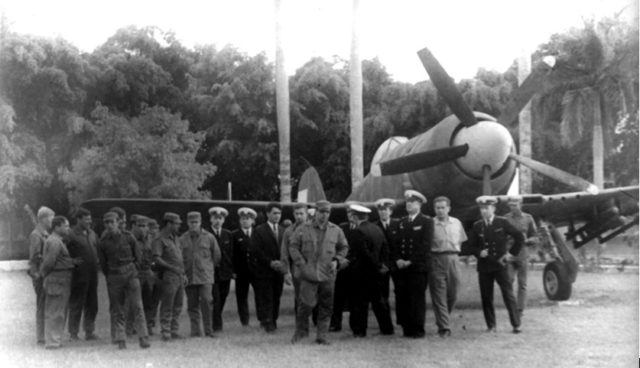
In 1980 A Soviet TU-95 Bear, flying from the USSR to Cuba, entered US airspace and passed very close to Langley AFB in Virginia (it could be seen from the control tower). The aircraft was intercepted by F-15s from the US Air Force 1st TFW and escorted out of US airspace.
In 1989, with the political changes in the USSR, Moscow pulled out its TU-95s from Cuba. In November 1999 Mikhail Oparin, Commander of the Russian Long Range Aviation, in an interview to the Russian magazine Nyezavisimoe Voyennoe Obozreniye (Independent Military Review), affirmed that it’s possible that Russia sends once again its TU-95s to Cuba after the year 2000. The Cuban Government, however, denied this.
After the collapse of the Soviet Union in 1991 the Bears did not return to Cuba. Although as of the time of this writing Russian Navy flights by TU-95 outside the Russian borders have happened in other parts of the world, mostly in the Northern Atlantic and Pacific Oceans, including Alaska, Guam, Hawaii and the American West Coast, these enormous flying machines still have to be seen flying along the North American east coast. The present political climate in Russia, however, may make those flights to the Caribbean a reality once again, like in the freezing days of the Cold War, with the added possibility of extending the flights from their old turf in Havana to a new turf further south of Cuba: Venezuela.
The Tupolev TU-142M (Bear F)
The long-range antisubmarine and patrol aircraft TU-142M (Bear F) belonged to the Soviet Naval Aviation. On March 21st, 1983, crews of the 76th Independent Antisubmarine Aviation Regiment (OPLAP in Russian), commanded by Majors N. N. Karpus’ and V. M. Bychkov carried out the first flight in the history of the regiment when they took off in a TU-142M from Kipelovo, Vologda, USSR, landing at the San Antonio de los Baños airbase some 16 hours later. Thus started a period of almost ten years of military service in the area of the Central Atlantic, seriously complicating life for the submarine forces of the potential enemy in the regions of combat alert.

From then on, the TU-142M took off from San Antonio in their search for American submarines in the Sargasso Sea. In their first flights they dropped 12 to 16 RGB-75 buoys every 30-40km. to cover a search surface area of some 12,000 sq. km. In 10 flights the crews reported 6 detected submarines. For target classification, they used RGB-55A buoys, and RGB-1 and RGB-15 buoys for tracking, which could last up to almost 12 hours. The American reaction was not unexpected. They did not like those flights from Cuba at all, but had to endure them since they made their own flights around the USSR over the Barents, Okhotsk, Japan, and others seas.
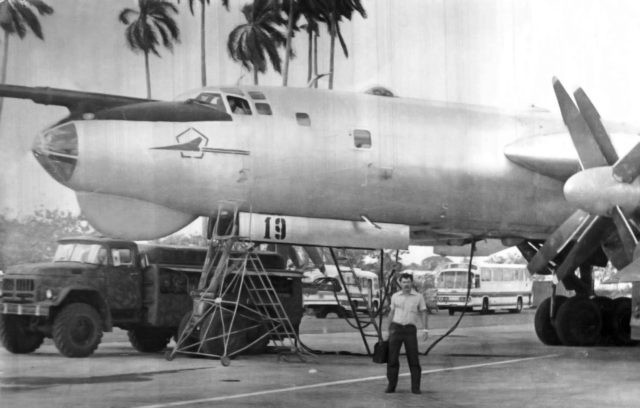
The TU-142M flew 2 to 4 times a month from San Antonio. When they landed they still had 5 to 7 tons of fuel, although sometimes, due to meteorological conditions, critical situations developed due to the higher fuel consumption caused by the storms, so they had to land at Holguín, some 1,000km closer, on the eastern end of the island. In those cases, the Soviet Naval Aviation representative in Havana (who officially was the Aeroflot representative in Cuba) made an urgent special flight to Holguín aboard a Cubana’s An-24 to receive them. The TU-142M also made frequent 16hr-long flights to Luanda, Angola, overflying the Southern Atlantic Ocean. Here they never met American interceptors.
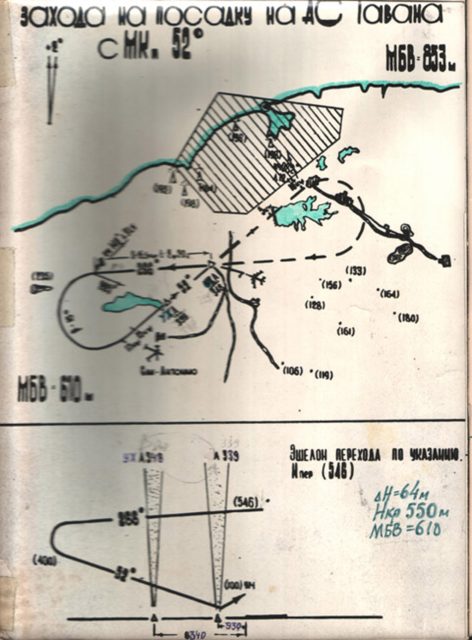
About this time, in San Antonio the Soviets built a revetment to hold up to eight TU-142 and TU-95, together with a centralized fueling system (that was never finished) and a repair shop. In this shop, the aircraft were repaired and their engines replaced. The engines frequently returned with damaged turbine blades. The pilots and technicians were housed in local hotels, two to a room, with daily bed linen change and meals at the hotel’s restaurant. For the Russians from the regiments at Severomorsk and Kipelovo, used to the harsh conditions of the Russian north, this was paradise. “The limits of our dreams,” they said. Their relations with the Cuban FAR (Revolutionary Armed Forces) personnel and with other Cubans were excellent, the Russians being amazed at the usual hospitable, humanitarian, and friendly character of the common Cuban. From 1983 on, the flights of the TU-142 became more effective. However, with the end of the Cold War, those airplanes were also pulled out of Cuba in 1989.
Russian Humor
The Russian crews said that the American interceptors sometimes got so close that they could see in the fighters cockpits the erotic magazines the pilots showed them, exhorting them by radio: “Come on, Russians, come, here we have freedom, women, whiskey…” However, the Americans were not the only ones showing those types of magazines. A Canadian veteran pilot tells the following story: “When I worked at the North Bay CFB (HQ of the Air Defense Command of NORAD’s 22nd Zone) I frequently used to see photographs of the Bears that probed our air defenses on their way from Russia to Cuba. Generally the RCAF sent a couple of CF-101 Voodoo interceptors to escort the Bear, one remained in station behind the Bear while the other took the photos. One of the photos had a Russian crewman showing the centerfold of the latest issue of Playboy. It was an issue so new that it had not arrived at North Bay yet, and the Russian was smiling from ear to ear. This was only a small sample revealing that they also have a sense of humor.”
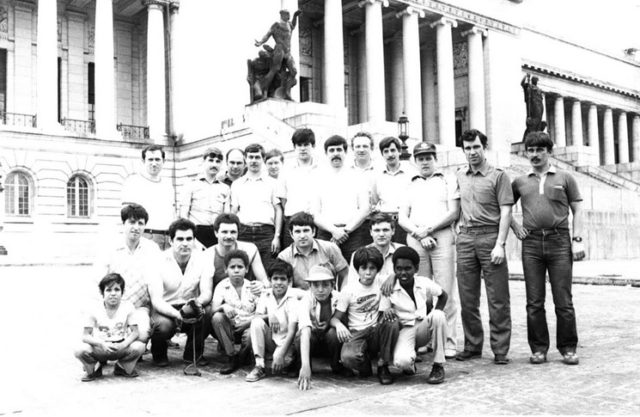
TU-95RTs Intercepted by MiG-21s of the Cuban FAR
In 1973 Cuba was still being overflown by Lockheed U-2 spy aircraft of the USAF. To intercept them in the stratosphere one had to have a certain readiness, plus their flight altitude gave only a few minutes to accomplish this. The Cuban FAR High Command studied those possibilities, and one of its combat maneuvers coincided with the customary flight of a pair of TU-95s to Cuba. These reconnaissance airplanes, due to their flight characteristics, altitude, speed, and mode of approach, were very similar to the U-2. The Soviet High Command agreed to have those airplanes intercepted in order to increase the Cuban pilots’ preparedness. The exercise was undertaken by several MiG-21F-13 from the airbase at Holguín, the area where the TU-95s entered the Cuban airspace. Three squadrons of MiG-21F-13 participated, “attacking” in pairs the two TU-95s, which were flying at a height between 10,000 and 12,000 meters and at a speed of 800 kph. The MiG-21s had to use their afterburners, but managed to intercept the TU-95s between Gibara and Puerto Padre and “shoot them down.” The exercise was satisfactory, but due to the characteristics of the flight, at the very limit of their range, the MiG-21F-13 landed at Camagüey. After the exercise the Cuban High Command gave the pilots the grade of “Satisfactory”, while the Russian pilots of the TU-95s gave them a grade of “Good”, highlighting the cleanliness of the attacks. Since the time to intercept this type of targets was very short, the Cuban pilots also analyzed the possibilities of a frontal attack utilizing IR missiles type K-13. The exercise showed the difficulties of intercepting a U-2, but also showed that it was perfectly possible.
Author: Miguel Vargas-Caba
